|
|
|
Darwin Station
Monday, January 31 2005
setting: Plaza Islands, Galapagos, Ecuador
Even before there was much morning light, the bell rang and we were taken on a short panga ride to today's destination, one of the Plaza Islands off the east coast of Santa Cruz. We went on a loop around the island, starting with the sea lions, working our way past the bird-rich cliffs, and then bidding adieu to land iguanas, Darwin finches, and warbler flycatchers. Today was the first day I came to regret my barefooted ways. I stubbed my right "pinkie toe" on a piece of lava and it bled for more than an hour. I was glad when our tour didn't backtrack over terrain we'd already covered, because I didn't want to know how Cezar would interpret the pools of blood I kept leaving.
This cruise of the Galapagos had been billed as an "eight day" cruise, but for various reason the actual cruising part was ending today. Because of a change in the scheduling of the Golondrina that had happened after Gretchen had booked our cruise, we would now have to spend our final day at a hotel in Puerto Ayora. This was all being paid for by the touring company, and they would even be coming up with activities for us in Puerto Ayora.
But for some reason even after we'd landed in Puerto Ayora and checked into our hotel (the Hotel Palmeras), we had to return to the Golondrina for one final lunch of fried fish and dismal vegetables. I'd had the same identical fried fish at nearly every meal (except breakfast) and something inside me assigned to this fact some of the blame for the deteriorating state of my health.
Early this afternoon I was feeling somewhat better, so Gretchen and I walked around Puerto Ayora looking for a place to get a beer. We saw several places that called themselves bars or that had signs mentioning the presence of cerveza, but in each of these we found that there actually wasn't any beer or that any beer we wanted would actually have to be bought at a nearby store. Finally, though, we found a grungy little café that actually had beer. Drinking a beer in Puerto Ayora is a rather different experience than drinking a beer at an American establishment; one of the children of one of the café employees was hanging out at the establishment firing very loud recreational explosives, kind of like in that scene from Boogie Nights. Nobody seemed to care except me, but what could I do?
Eventually we saw our Galapagos guide, Cezar, walking by. Puerto Ayora is like that. It's like Woodstock, New York. You don't have to sit anywhere very long before you begin to recognize the same faces being recycled over and over: the young woman on a bicycle in the impossibly short skirt or the white woman with the black dog who we'd seen earlier during our unsuccessful attempt to withdraw money from Puerto Ayora's only ATM. Before long we were even recognizing the dogs.
We invited Cezar over for a beer and he gladly accepted. He's 68 years old and works a little too hard for a man that age. When we'd been in Black Turtle Cove, he'd had to row the panga so as not to disturb the wildlife, and the exertion had drenched him in sweat. On other occasions, such as when we'd gone snorkeling, he'd routinely swum in the strongest, most difficult of currents. Over the course of many conversations, Gretchen had determined that Cezar has a girlfriend in Puerto Ayora, but he doesn't get to see her too often.
Over our beers today, Gretchen asked Cezar about the many stray dogs of Puerto Ayora. Cezar said that they're all supposed to be wearing tags, and those that aren't are eventually killed by being fed poisoned meat. Like most third world villages, Puerto Ayora doesn't have a system of animal shelters. Gretchen and I had noticed that most of Puerto Ayora's dogs seemed to be walking about in pairs, one with a collar and a tag, the other without.
In the mid-afternoon we were supposed to get a tour of Darwin Research Station (just outside of Puerto Ayora), so we went down to the harbor and waited for our guide, who we assumed would be Cezar. We could even see a guy who looked like Cezar out on the Golondrina. So we sat around and waited. Finally a panga came in from the Golondrina and our guide was on it. He was a little shrunken old man like Cezar, but it was someone else. His name was Bolivar, and he would serve as our guide in Puerto Ayora. Impossibly, Bolivar's English was far worse than Cezar's. We could only make sense of what he was saying when he spoke Spanish. Two out of three of the others remaining in our group (the French couple and the German woman) understood Spanish, so this wasn't as much of a handicap as it might have been. But there was another problem as well; Bolivar liked to pad his conversations with irrelevant stories about himself. Gretchen kept seeing him glancing at his watch and she figured his job was to occupy our time, and that it didn't matter to his employers how he chose to do it.
In the harbor, Bolivar hailed a pickup truck cab to take Gretchen and me to Darwin Station. Along the way we found the French couple and the German woman, so we stopped and they climbed in. Once there, Bolivar proceeded to give us a long and not especially exciting tour of the research station. We saw plenty of giant tortoises and land iguanas, but the pacing was all wrong. Whenever we were enjoying ourselves Bolivar would hurry us along, and whenever there was nothing much to see, Bolivar would hang back and wait. Adding to our misery was the inescapable tropical sun.
By the end of our Darwin Station experience, I was so weak I had to lie down on a bench. Eventually Gretchen and I said we'd had enough and that we were leaving. I expected it to be a rather long hike, but walking back to the hotel wasn't much of an ordeal. Simply breaking free of the restrictions of our tour was enough to restore my health.
Our experience at Hotel Palmeras was proving to be a mixed one. On the one hand, they had a nice big pool that nobody seemed to use except us. On the other hand, only cold water came from the shower faucets in our bathroom. And I could only find one broadcast channel on the room's television. (I guess the Galapagos must have a teevee station.) We'd yet to encounter the worst aspect of the Hotel Palmeras, its restaurant.
At the last second Gretchen informed the Palmeras restaurant staff that she doesn't eat meat, and yes, this means she doesn't eat fish either. So they brought her out a big disgusting omelette. She ate a few mouthfuls and felt sick. Later she figured out that it must have somehow been prepared in lard. Meanwhile I was struggling through a dish of beef, french fries, and rice (since I cannot eat omelettes, the only non-meat dish the Palmeras cooks can imagine). The beef wasn't so bad but the fries were disgusting. I tried improving them with ketchup, but wouldn't you know, the ketchup was watered down to the most horrifying consistency ketchup can possibly have.
As for the others at our table, the French couple and the German woman, they seemed to be happy with their food. Conversation shifted to other topics, with some things being said in Spanish and English things being translated into French. The French woman gave Gretchen tomorrow's itinerary in Spanish, but Gretchen didn't follow it perfectly. This was demonstrated by a question Gretchen asked several minutes later. Somewhat condescendingly, the German woman, who had been on Gretchen's nerves from the start (and not only because she was German), referred Gretchen back to what the French woman had said "in Spanish." "But I didn't understand!" Gretchen protested. This was only one of several manifestions of Gretchen's testiness that happened over the course of tonight's meal. I thought Gretchen was maybe being a wee bit too harsh, but I could understand her frustration. Mind you, it wasn't just the German woman who had Gretchen feeling this way. She was also growing tired of constantly having to translate things into French for the French woman (the lowest-key person at the table, whom Gretchen jokingly referred to as "Frenchie" after dinner).
Though our dinner was being paid for by our touring company, the others at our table made an effort to tip the staff on their way out. There was no way Gretchen and I would be tipping for an experience like that, particularly in a nation where tipping is optional, so we awkwardly ducked around the others and fled. Sometimes being the Ugly American is the most honorable course of action.
Earlier this evening, while I'd been attempting to nap, Gretchen had gone on a walk into the less touristy parts of Puerto Ayora. There she'd stopped at a streetside food stand and bought a freshly-roasted plantain containing a tiny amount of cheese. An incredulous onlooker had asked her "Le gusta?" Evidently he'd never in his life seen a white woman deliberately eat a roasted plantain.
So after our dismal dinner Gretchen and I took another walk through that same neighborhood. Cats and dogs lay sprawled on kirchen floors whose doors to the outside were wide open. Children played the way children always do.
There are two unusual things about the urban landscape of Puerto Ayora. First of all: none of the buildings look finished. At the top of all of them are long whips of rebar, as if the orignal plans for the building had called for several more stories, but the money had run out and the builders had to slap a roof on what had been completed.
The other strange thing about Puerto Ayora is the nature of the yards. None of them contain grass or any sort of ground-covering vegetation. Instead, the soil (such as it is) is completely covered with fist-sized cobblestones, usually in a steep pile. Often there is plenty of construction debris mixed in with these cobbles. This debris usually consists of broken concrete blocks, though it can also be things like bails of rebar or PVC pipe. To the American sensibilty, the appearance of such yards comes as something of a shock, but Puerto Ayora is a semi-arid place in the third world, and there's no water for irrigation.
Where exactly Puerto Ayora fits on the first-world/third-world continuum is a little tricky to ascertain. In the touristy parts of town, for example, nearly every block has an internet café. That's not just first world, that's high tech first world. But then there are the many little details that are decidedly third world, things as trivial as the unrelieved fragrance of electrical fire on the street in front of our hotel. And while store merchandis might cost more in Puerto Ayora because everything has to be shipped in, probably many of Puerto Ayora's residents have figured out how to live a nearly cash-free existence. Judging from "urban" land use patterns, taxes are low and development pressures are weak. And if a guy can get an occasional ham hock from his brother-in-law in exchange for storing a pile of PVC pipes in the front yard, sure, hell, he'll do it.
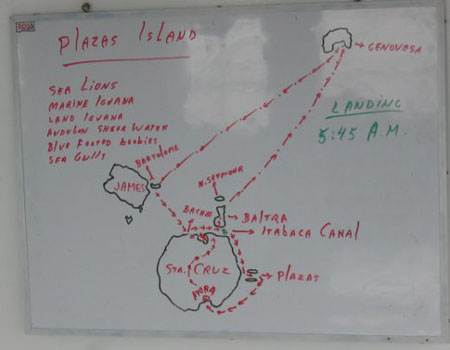
The Golondrina whiteboard this morning.
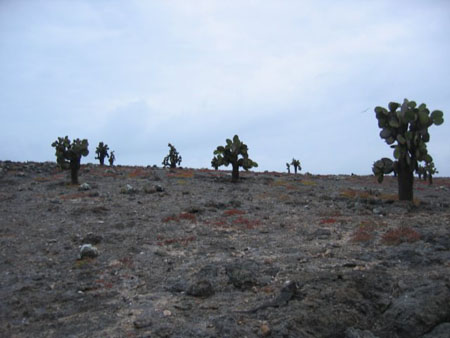
Prickly pear tree cactus on one of the Plaza Islands.
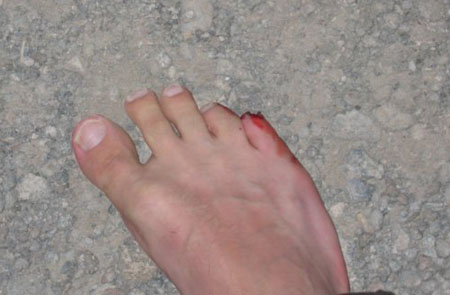
My bleeding toe on one of the Plaza Islands.
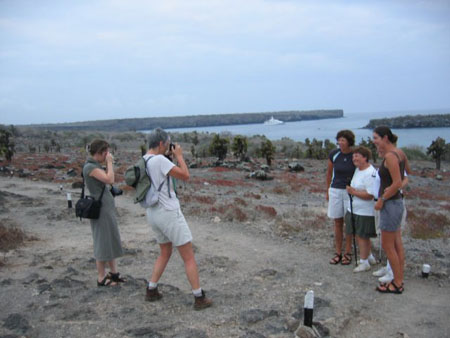
The Australians (with an American from another boat) being photographed by one of the Swedes and another American on one of the Plaza Islands.
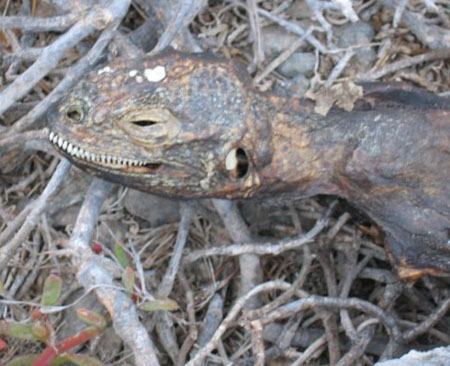
A mummified land iguana on one of the Plaza Islands.
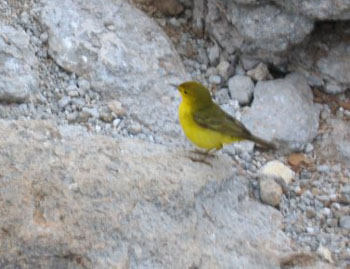
A warbler flycatcher on one of the Plaza Islands.
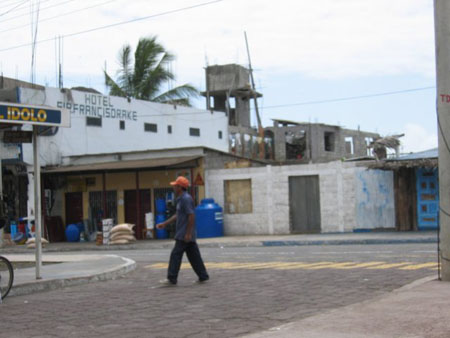
The streets of Puerto Ayora. You can see the rebar whips atop the buildings.
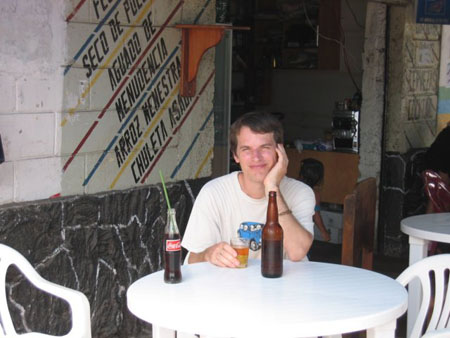
Me drinking a beer at a café in Puerto Ayora. There are only two major brands of beer in Ecuador: Club and Pilsener.
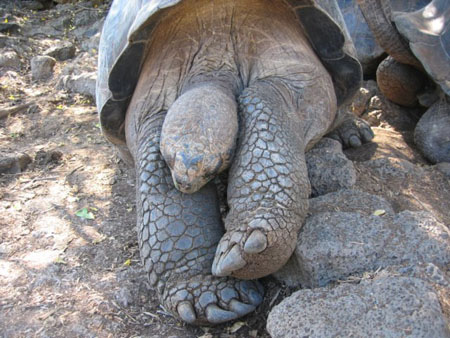
A giant tortoise at Darwin Station. It's difficult to see tortoises in the wild in the Galapagos because they have become so rare.
Many of the endangered varieties have been placed in breeding programs at Darwin Station, and some of these programs have been working well. Unfortunately, though, the concentrated diversity at Darwin Station it itself a vulnerability. Some years ago a group of irate fisherman, incensed about new fishing limits, took over Darwin Station and threatened to kill the tortoises.
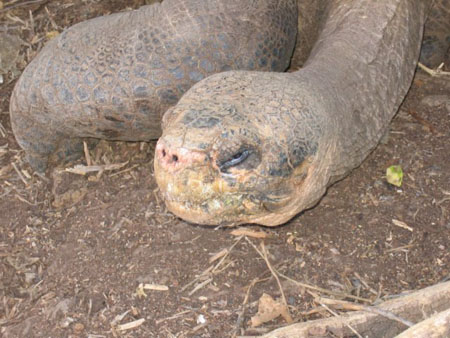
A tortoise's head at Darwin Station.
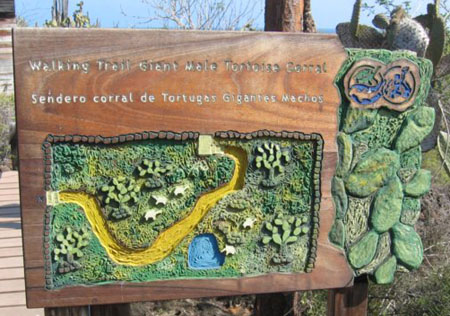
A sign at Darwin Station.
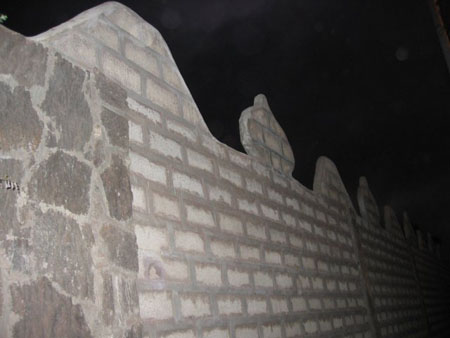
An interesting wall in non-touristy Puerto Ayora.
For linking purposes this article's URL is:
http://asecular.com/blog.php?050131 feedback
previous | next |











